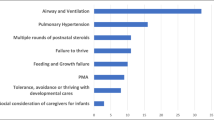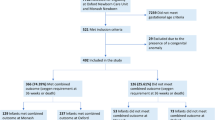Abstract
Objectives
To assess respiratory care guidelines and explore variations in management of very low birth weight (VLBW) infants within a collaborative care framework. Additionally, to gather clinical leaders’ perspectives on guidelines and preferences for ventilation modalities.
Study design
Leaders from each NICU participated in a practice survey regarding the prevalence of unit clinical guidelines, and management, at many stages of care.
Results
Units have an average of 4.3 (±2.1) guidelines, of 9 topics queried. Guideline prevalence was not associated with practice or outcomes. An FiO2 requirement of 0.3–0.4 and a CPAP of 6–7 cmH2O, are the most common thresholds for surfactant administration, which is most often done after intubation, and followed by weaning from ventilatory support. Volume targeted ventilation is commonly used. Extubation criteria vary widely.
Conclusions
Results identify trends and areas of variation and suggest that the presence of guidelines alone is not predictive of outcome.
This is a preview of subscription content, access via your institution
Access options
Subscribe to this journal
Receive 12 print issues and online access
$259.00 per year
only $21.58 per issue
Buy this article
- Purchase on Springer Link
- Instant access to full article PDF
Prices may be subject to local taxes which are calculated during checkout




Similar content being viewed by others
Data availability
The dataset generated during the current study is not publicly available as it contains identifiable information, but is available from the corresponding author on reasonable request.
References
Vermont Oxford Network. Very low birth weight database [Available from: https://public.vtoxford.org/data-and-reports/vlbw-database/.
Guttentag S. Respiratory Distress Syndrome. In: Eichenwald EC, Hansen AR, Martin CR, Stark AR, editors. Cloherty and Stark’s Manual of Neonatal Care. 8th ed. Philadelphia: Wolters Kluwer; (2017).
Horbar JD, Edwards EM, Greenberg LT, Morrow KA, Soll RF, Buus-Frank ME, et al. Variation in performance of neonatal intensive care units in the United States. JAMA Pediatr. 2017;171:e164396.
Boghossian NS, Geraci M, Lorch SA, Phibbs CS, Edwards EM, Horbar JD. Racial and ethnic differences over time in outcomes of infants born less than 30 weeks’ gestation. Pediatrics 2019;144:e20191106.
Beltempo M, Isayama T, Vento M, Lui K, Kusuda S, Lehtonen L, et al. Respiratory management of extremely preterm infants: an international survey. Neonatology 2018;114:28–36.
Mukerji A, Shah PS, Shivananda S, Yee W, Read B, Minski J, et al. Survey of noninvasive respiratory support practices in Canadian neonatal intensive care units. Acta Paediatr. 2017;106:387–93.
van Kaam AH, Rimensberger PC. Lung-protective ventilation strategies in neonatology: what do we know-what do we need to know? Crit Care Med. 2007;35:925–31.
Shalish W, Anna GMS, editors. Respiratory care protocols in neonatal intensive care (2016).
van Kaam AH, Rimensberger PC, Borensztajn D, De Jaegere AP. Ventilation practices in the neonatal intensive care unit: a cross-sectional study. J Pediatr. 2010;157:767–71.e1-3.
Klingenberg C, Wheeler KI, McCallion N, Morley CJ, Davis PG. Volume-targeted versus pressure-limited ventilation in neonates. Cochrane Database Syst Rev. 2017;10:CD003666.
Keszler M. Volume-targeted ventilation: one size does not fit all. Evidence-based recommendations for successful use. Arch Dis Child Fetal Neonatal Ed. 2019;104:F108–F12.
Gupta A, Keszler M. Survey of ventilation practices in the neonatal intensive care units of the United States and Canada: use of volume-targeted ventilation and barriers to its use. Am J Perinatol. 2019;36:484–9.
Healy H, Croonen LEE, Onland W, van Kaam AH, Gupta M. A systematic review of reports of quality improvement for bronchopulmonary dysplasia. Semin Fetal Neonatal Med. 2021;26:101201.
Pfister RH, Goldsmith JP. Quality improvement in respiratory care: decreasing bronchopulmonary dysplasia. Clin Perinatol. 2010;37:273–93.
Balakrishnan M, Raghavan A, Suresh GK. Eliminating undesirable variation in neonatal practice: balancing standardization and customization. Clin Perinatol. 2017;44:529–40.
Wennberg JE. Time to tackle unwarranted variations in practice. BMJ. 2011;342:d1513.
Horbar JD, Carpenter JH, Badger GJ, Kenny MJ, Soll RF, Morrow KA, et al. Mortality and neonatal morbidity among infants 501 to 1500 grams from 2000 to 2009. Pediatrics. 2012;129:1019–26.
Shalish W, Keszler M, Davis PG, Sant’Anna GM. Decision to extubate extremely preterm infants: art, science or gamble? Arch Dis Child Fetal Neonatal Ed. 2022;107:105–12.
Gupta D, Greenberg RG, Sharma A, Natarajan G, Cotten M, Thomas R, et al. A predictive model for extubation readiness in extremely preterm infants. J Perinatol. 2019;39:1663–9.
Kanbar LJ, Shalish W, Onu CC, Latremouille S, Kovacs L, Keszler M, et al. Automated prediction of extubation success in extremely preterm infants: the APEX multicenter study. Pediatr Res. 2022;93:1041–9.
Prakash R, De Paoli AG, Davis PG, Oddie SJ, McGuire W. Bubble devices versus other pressure sources for nasal continuous positive airway pressure in preterm infants. Cochrane Database Syst Rev. 2023;3:CD015130.
Gokce IK, Kaya H, Ozdemir R. A randomized trial comparing the short binasal prong to the RAM cannula for noninvasive ventilation support of preterm infants with respiratory distress syndrome. J Matern Fetal Neonatal Med. 2021;34:1868–74.
Sharma D, Murki S, Maram S, Pratap T, Kiran S, Venkateshwarlu V, et al. Comparison of delivered distending pressures in the oropharynx in preterm infant on bubble CPAP and on three different nasal interfaces. Pediatr Pulmonol. 2020;55:1631–9.
Eze N, Murphy D, Dhar V, Rehan VK. Comparison of sprinting vs non-sprinting to wean nasal continuous positive airway pressure off in very preterm infants. J Perinatol. 2018;38:164–8.
Yang CY, Yang MC, Chu SM, Chiang MC, Lien R. A randomized pilot study comparing the role of PEEP, O(2) flow, and high-flow air for weaning of ventilatory support in very low birth weight infants. Pediatr Neonatol. 2018;59:198–204.
Todd DA, Wright A, Broom M, Chauhan M, Meskell S, Cameron C, et al. Methods of weaning preterm babies <30 weeks gestation off CPAP: a multicentre randomised controlled trial. Arch Dis Child Fetal Neonatal Ed. 2012;97:F236–40.
Acknowledgements
We would like to acknowledge the clinical leaders at all participating NICUs for participating in this survey.
Author information
Authors and Affiliations
Contributions
HH, MG, and MA conceptualized and designed the study, including the survey questions. HH performed initial analyses. HH, Bernadette Levesque, KTL, RV, EW, SC, JG, SG, BS, MG, and MA participated in review and interpretation of the results. HH and MA drafted the initial manuscript. All authors then critically reviewed and revised the manuscript. All authors approved the final manuscript as submitted and agree to be accountable for all aspects of the work.
Corresponding author
Ethics declarations
Competing interests
The authors declare no competing interests.
Additional information
Publisher’s note Springer Nature remains neutral with regard to jurisdictional claims in published maps and institutional affiliations.
Rights and permissions
Springer Nature or its licensor (e.g. a society or other partner) holds exclusive rights to this article under a publishing agreement with the author(s) or other rightsholder(s); author self-archiving of the accepted manuscript version of this article is solely governed by the terms of such publishing agreement and applicable law.
About this article
Cite this article
Healy, H., Levesque, B., Leeman, K.T. et al. Neonatal respiratory care practice among level III and IV NICUs in New England. J Perinatol (2024). https://doi.org/10.1038/s41372-024-01926-2
Received:
Revised:
Accepted:
Published:
DOI: https://doi.org/10.1038/s41372-024-01926-2



